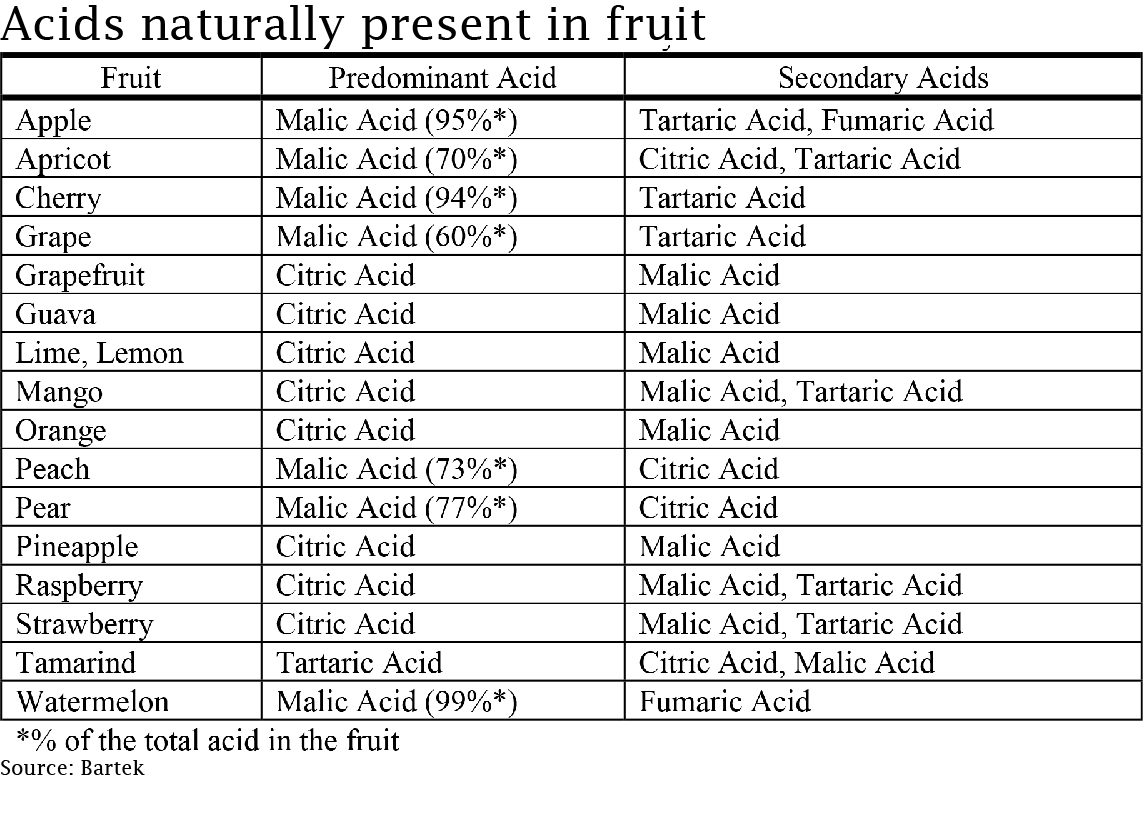 CHICAGO — Food-grade acidulants allow beverage developers to give their creations a flavorful twist. Some acids boost sweet perception while others influence sour and tart notes. Through careful crafting, it’s possible to develop signature flavor profiles.
CHICAGO — Food-grade acidulants allow beverage developers to give their creations a flavorful twist. Some acids boost sweet perception while others influence sour and tart notes. Through careful crafting, it’s possible to develop signature flavor profiles.
“Different acidulants influence fruit taste profiles and allow formulators to align the flavor with varying consumer preferences,” said Jeff Billig, vice-president of marketing and business development, Bartek Ingredients Inc., Ontario. “They allow for a more complex flavor profile while keeping the ingredient statement short and simple.”
Bartek explored the impact of citric, fumaric and malic acids in a peach mango juice beverage. Higher upfront sweetness was perceived with citric acid, while the malic or fumaric acid provided a more true-to-fruit flavor roundness. The beverage with fumaric acid was perceived as sweeter and less sour than the other acids.
“When you add all three acids at different levels, that’s where flavor development gets fun,” Mr. Billig said. “Manipulating the three acid levels should have no impact on juice color or mouthfeel, as long as pH is maintained.”
The flavor profile of most fruit-flavored products, not just beverages, but also condiments, jams/jellies and confections, may be significantly improved by using a mixture of acidulants. This is because most fruits contain more than one acid. (See table.) By blending acidulants, a more authentic fruit flavor comes through in the finished product.
 Acidulants are particularly useful in beverages made with fruit flavors, such as the growing number of flavored carbonated waters in the market. Even beverages made with real fruit juice may be flavor challenged. This is because most whole fruits contain 0.5% to 2.0% total acid, which contributes to their familiar flavor. Some of the acid is lost during juice processing and pulp removal. Adding back acids makes the fruit profile more authentic.
Acidulants are particularly useful in beverages made with fruit flavors, such as the growing number of flavored carbonated waters in the market. Even beverages made with real fruit juice may be flavor challenged. This is because most whole fruits contain 0.5% to 2.0% total acid, which contributes to their familiar flavor. Some of the acid is lost during juice processing and pulp removal. Adding back acids makes the fruit profile more authentic.
Citric, malic and tartaric acids are all very soluble in water. Fumaric acid often needs additional time to properly dissolve in a water solution. Fumaric acid also is one of the strongest (lowest pH) of the acidulants often added to beverages and is said to have a higher relative sourness. Malic acid has a higher relative sourness than citric acid, even though its pH is higher. This is because malic acid has a more prolonged sour sensation in the mouth than citric acid. It is this sourness and contribution to tart taste that has many beverage formulators exploring how acidulants allow for flavor innovation and modification.
“Formulators can use malic acid as a tool to modify sweetness of high-intensity sweeteners,” Mr. Billig said. “And fumaric acid can be used to decrease pH without increasing sourness in acidified beverages containing proteins.”
In some instances, beverage formulators use concentrated fruit juices high in specific acidulants to make fruit flavors come alive and shine. That is likely the strategy behind Newton, Mass.-based Spindrift Beverage Co.’s namesake line of sparkling waters that claim to be flavored with only fruit. In addition to containing juice and puree of the characterizing fruit, the beverages include lemon juice, which is a naturally concentrated source of citric and malic acids.
Minute Maid’s Simply brand from The Coca-Cola Co., Atlanta, also relies on lemon juice for flavor enhancement in its new line of chilled, ready-to-drink Simply smoothie fruit smoothies. In addition to being made with not-from-concentrate juices and purees, the smoothies contain natural flavors.
Beverages such as V8 Splash juice blends from the Campbell Soup Co., Camden, N.J., and Bai Supertea fruit-juice infused ready-to-drink teas from Dr Pepper Snapple Group, Plano, Texas, use a combination of ingredients, including citric and malic acids, to enhance fruitiness while balancing overall flavor profile.
Food grade acidulants functioning as acid regulators or flavor enhancers in beverages may simply be declared by name on ingredient statements, e.g., citric acid, malic acid, etc. If the acidulant is part of a flavor system, it need not be declared by name and simply falls under the generic description of “flavor,” which should be specified as being either natural or artificial, based on how it is obtained.




